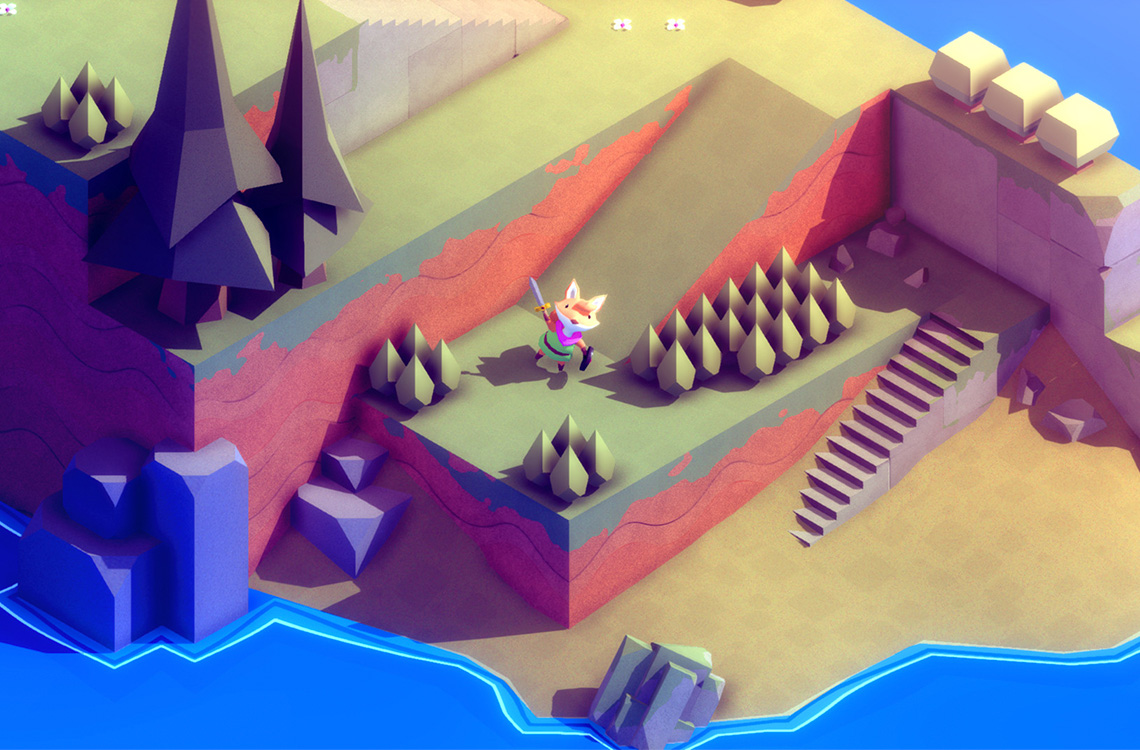With a hands-off approach, Tunic is all about letting the player teach themselves how to play the game by collecting manual pages.
This year’s indie darling, and a shoo-in for game–of-the-year lists, is a game that seemingly rehashes previous games and genres. We can easily compare Tunic, published by Finji, to early games in the Zelda franchise, and even 2019’s The Legend of Zelda: Link’s Awakening, but at times, the combat and enigmatic world remind me of Hyper Light Drifter, while the gorgeous art and isometric layout give off big Fez vibes. But while you can find and play dozens of isometric RPGs, Tunic escapes a “generic” label with how it communicates important information to the player.
(Spoiler warning: This article contains spoilers on gameplay mechanics.)
In Tunic, there are no tutorials, tips, or hints, and everything in the world is spelled in an alien rune-like language. When you begin, the game expects you to know the basic mechanics of a game like this — e.g., how to move and attack — which is second nature to any gamer. Beyond that, however, you’re on your own.
At least that’s what it initially feels like, but with the help of the manual, players learn how to play the game and uncoverTunic ’s secrets. But other games have manuals, too, except that in Tunic, players don’t start the game with the manual. Instead, manual pages are scattered throughout the game’s world, leaving the challenge of collecting the pages to the player. It’s honestly one of the most clever pieces of game design I’ve experienced as a player in years.

After decades of manual-less games, Tunic makes manuals relevant again while reinventing them for a modern audience. The manual is beautifully drawn and formatted. Every page is rich with art, maps, weapon diagrams, and useful information that every other game would prefer to just tell you about on a loading screen or in a pop-up. More than a pack-in booklet with instructions, Tunic’s manual is both a tool to understand the game and a challenge to complete. It drives the player and serves as a key to the plot.
While the beginning of the game is too tropey with the same “amnesiac protagonist” shtick we’ve seen 100 times, the game actually delivers by not telling you a single thing about the world or explaining how the game works. The character doesn’t remember anything; therefore, the player doesn’t either.
Committing to the bit, or in this case, the narrative, is risky if the player decides the game is too obtuse, but manual pages begin appearing within the first few minutes of the game. Finding a page, however, isn’t everything. Information is often spread across multiple pages. In some cases, a manual page will contain a section with references to another page, requiring both pages to reveal some important piece of information or gameplay mechanic. In other cases, players will find an incomplete two-page spread, which reveals only half of a map or illustration. Sometimes, as in the case of ability cards, the manual will only reveal the name but not what the item does. And there are many instances where all a player has to go by is a diagram or an illustration depicting a certain gameplay action.





Further complicating things is the language used in the pages, of which very little appears in English — it didn’t take the community very long to crack the language. The pages aren’t totally hard to parse, thanks to the many tips and drawings scribbled in pen throughout. That the game designer chose to reveal information via this method instead of in the printed text extends even more believability to the world. It has a whole Harry Potter and the Half-Blood Prince feel to it, showing, not telling the player, that the manual has passed through other hands.
Narratively, this also carries the idea that the mission has been attempted before, however many times, and that, if the character is doing it now, it means it hasn’t worked before. The manual is a link connecting the past and present for the purpose of completing a single goal, which is itself revealed in the manual.
Completing the manual is more than an achievement to be checked off for completionists; collecting all 28 double-sided pages (56 pages in total) is how players unlock the true ending. The bad ending involves one of the hardest boss fights I’ve ever experienced, and I say that after putting 30 hours in Elden Ring, but collecting all the pages comes with its own challenges. Pages appear at a fast clip at first, but the frequency drops off near the endgame.
For diligent players who check every room and chest, the manual should be mostly complete by the time the endgame rolls around. However, collecting the last few pages to unlock the true ending is time-consuming, which keeps the game interesting in the 20-odd hours it takes to fully complete it, according to How Long To Beat. The consensus is that putting in the extra time to unlock the true ending is worth it. I still haven’t gotten around to it, to be honest, but I don’t have to beat it to appreciate the genius of the manual, or the man whose idea it was.




The sole developer of the game, Andrew Shouldice, puts an unbelievable level of trust in the player, revealing in an interview with Inverse that he was scared people wouldn’t get it because “it’s a game that lets you go the wrong way. If you don’t read the manual, you can get really stuck.” He’s very right. I recall times when I wandered for an hour or two, not really knowing where I was supposed to go next. But instead of feeling like my time was wasted, finding useful items and manual pages during my detours added meaning to getting lost. It meant that when the path finally revealed itself, I usually had a better understanding of the objective or a new mechanic gleaned from those new manual pages.
Admittedly, the pace at which the pages turned up was frustrating at first since I didn’t even know how to do the most basic actions such as leveling up, fast traveling, and unlocking amulet slots until those pages revealed themselves. But to be fair, that “eureka” moment when I finally figured something out offset my frustrations, and I became hooked on finding the next secret.
Realizing that the statue or platform I passed dozens of times had a hidden function all along was a delight that, from one moment to the next, expanded the scope of the world in my mind. It makes players want to explore every inch of the game. But also, it makes players meticulously pore through each page of the manual until they solve every mystery. For those who grew up in the golden era of manuals, Tunic will surely bring back memories.

My favorite part of buying a game when I was growing up was reading the manual on the drive home. Video game publishers have since done away with the manual to save a buck, but that’s not to say players don’t want manuals. Collectors pay obscene amounts on eBay for loose manuals to have a CIB (complete in box) copy of a retro game. And publishers like Limited Run Games and Iam8bit have made a business of shipping physical copies of retro and indie games with gorgeous manuals and other add-ons. But Tunic takes it a step further by making the manual the core of its game design rather than a supplementary document.
The developers understand it’s human to be curious, to turn over every rock and wonder what’s around a dark corner, and the game allows it. The manual, on the other hand, encourages it.
All images via Finji.
Looking for music or sound effects for your own game designs? We’ve got you covered.




